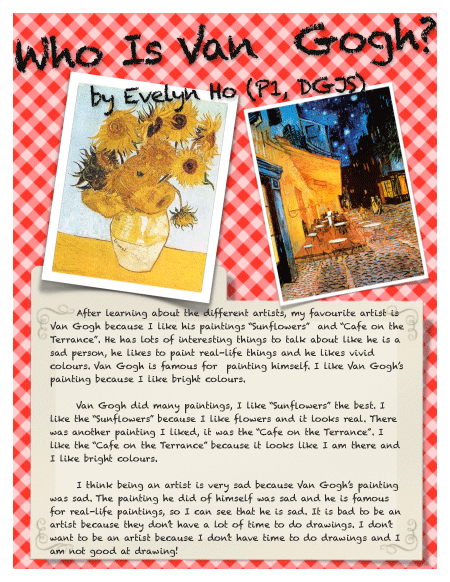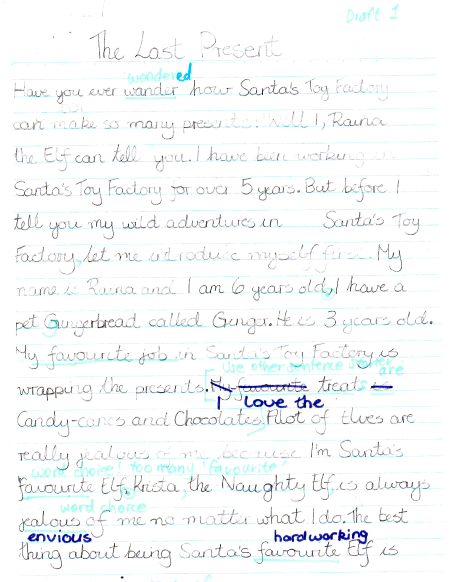Past Program
Journeys: What do I learn from different kinds of journeys?
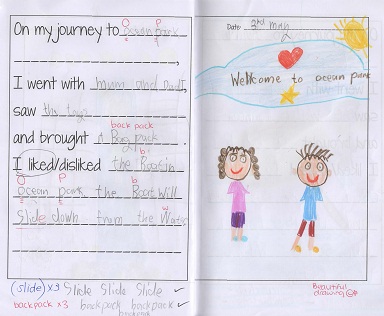
Program:
Kindergarten Topical
Audrey Lin
Y3, CCKG
Writing Foundation: Descriptive Writing
The students were taught:
- Techniques for Descriptive writing: Adjectives, Similes, Descriptive words, Sentence Variety, Adding details
- How to start an essay with a “hook”
- The structure of an essay and the components for each paragraph
- Different ways to elaborate an essay (use descriptive details, use your five senses, use personal stories)
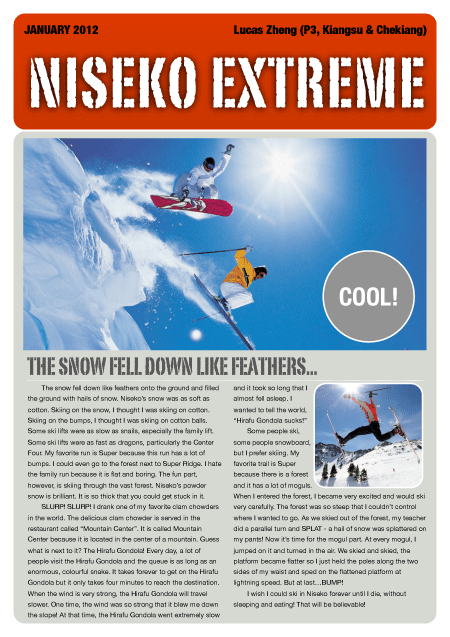
Read PDF
Program:
Writing Foundation
Lucas Zheng
P3, Kiangsu & Chekiang
Writing Foundation 0: Animal Narratives
Students were taught:
- Facts about animals in a variety on ecosystems
- The definition of a narrative
- Outlining the beginning, middle and end of a story
- How to use the past tense in narratives
- How to use dialogue in a story
Read PDF
Program:
Writing Workshop
Audrey Lin
Finished K3, CCKG
Writing Foundation: Fables
Students were taught:
- Techniques for writing a fable: personification, sentence transition, adding dialogues, synonyms of "said", different sentence structures
- Components of a table: animal characters, setting, story, structure, moral
- Editing skills: capitalization, punctuation, commas, speech marks, spelling
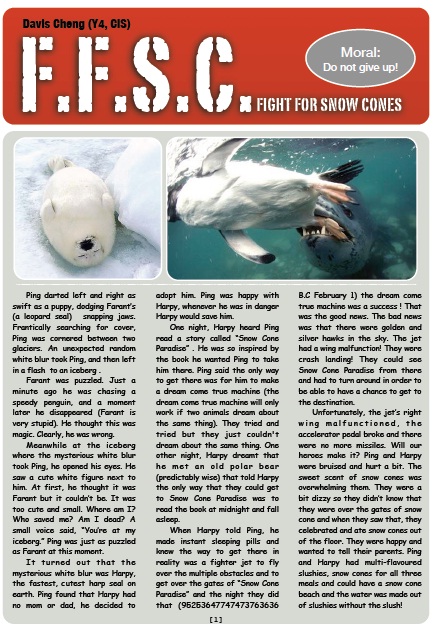
Read PDF
Program:
Writing Foundation
Davis Cheng
Y4, CIS
Writing Foundation: Narrative
Students were taught:
- Techniques of narrative writing: strong verbs, exciting sentence starters, 5 ways to introduce a story
- Process of narrative writing: brainstorming, story map, outline, revising
- Editing skills: improve weak phrases, action chains, punctuation, speech marks
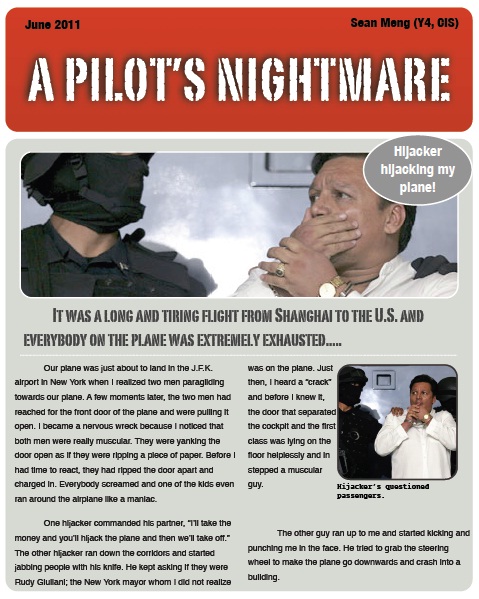
Read PDF
Program:
Writing Foundation
Sean Meng
Y4, CIS
Writing Foundation: Descriptive Writing
Students were taught:
- Techniques for Descriptive Writing: adjectives, similes, descriptive words, sentence variety adding details
- How to start an essay with a "hook"
- The structure of an essay and components of each paragraph
- Different ways to eleborate an essay
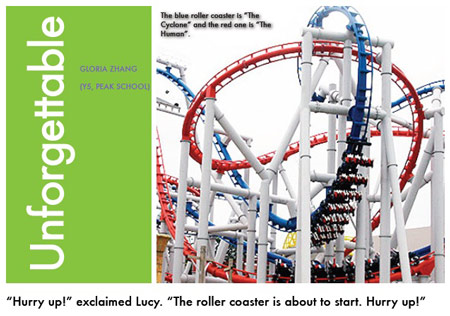
Read PDF
Program:
Writing Foundation
Gloria Zhang
Peak School, Y5
Winning
Win [win] verb: To gain the victor.
“Winning isn’t everything; it’s the only thing.”
Every day, victors and losers live among us, competing in simple everyday activities. Sometimes, the result could mean a small bet, maybe ten to twenty dollars, yet a similar situation’s results could be huge, where the result of a victory could mean the beginning or end of a career. Yet no matter what we do in our lives, competition is what fuels us, and winning is the only way for us to improve and get better, to gain an upper hand in our lives. With winners there are always losers, and from losing, we can always learn from our mistakes. Yet losing only appears from a result of a victory, as win-win situations are impossible to achieve. Through determining victors, we can discover the values of discipline, teamwork, moral values, as well as learning from our mistakes after taking a difficult loss. Winning will always drive us to improve, and winning is “the only thing”
Win [win] verb: To get by effort, as through labor, competition, or conquest.
“I can accept failure, everyone fails at something. But I can’t accept not trying.”
These words came from Michael Jordan, six time NBA champion, oftentimes known as the greatest athlete to set foot on the Earth. His discipline and hard work is shown on the basketball court. Every day during practice, Jordan would arrive 3 hours earlier, just to get a head start on his teammates, to practice to get better. Every night after practice was over, Jordan would yet again stay another three hours, mastering the skills that he had learnt earlier that day. Considered to be his apprentice Kobe Bryant follows the same work ethic. Every summer, Kobe would perform what he calls the “Blackout Workout”. He would work himself to the limit, running laps and shooting jump shots, until as the name suggests, he blacks out. The hard work of these two men allowed them to share eleven NBA championships between them, as their success can only be result of their hard work and their passion to win for the game. NBA legend Larry Bird possessed the same attitude as well. He sought to win against his greatest rival Earvin “Magic” Johnson, as hard work allowed his Boston Celtics to win the championship against Magic’s Los Angeles Lakers in 1984. Whenever one of his teammates wouldn’t be working to their fullest in practice, Larry would constantly be there chiding them, forcing them to improve upon themselves. Yet the results were clear, as the Celtics increased their workload and practice time, their results as players and as a team significantly rose, as Larry Bird’s Celtics were able to grab three NBA titles in six years. Larry’s thirst and determination to win was driven through hard work and discipline. To Larry, winning is the only thing, as his competitive eagerness drives him to work harder. There had been one game in 1986 when Bird had fractured the muscle in his eye, giving him double vision for the remainder of the game. Knowing that the team wouldn’t succeed without him, and fueled by his hunger to win, he never told his coach about the injury until the end of the game after he had sealed the win with a three-pointer to give the Celtics a ten point lead. Hard work always gets you somewhere, and as these three men have shown, their hard work has allowed their teams to be considered some of the greatest teams assembled, as well as these three men considered to be some of the greatest basketball legends since the inauguration in 1947, victors and winners in their own field.
Win [win] verb: To succeed in a team activity.
“The achievements of an organization are the results of a combined effort of each individual.”
NFL coach Vince Lombardi proclaimed these words after he led his Green Bay Packers to victory in 1960. Individuals win the regular season, but teamwork wins champions. This well-known motto of the NBA surges through the association, with the past seven MVP (Most Valuable Player) award winners not winning the championship in their respective years. There is no “I” in “Team” and to win is to also teach the values of teamwor, allowing the many teams in the sporting industry to win. Wilt Chamberlain was an NBA player living in the 1960s who spent the majority of his time trying to break records throughout the regular season, yet because of his selfish individualistic ideology, he had only been able to grab two titles in his hand, both of them at the end of his career, when he had finally been able to grasp his concept of a team. Meanwhile, his biggest rival Bill Russell was able to capture eleven NBA championships, allowing his Boston Celtics to then set NBA records as well, yet still incorporate the team game. During a blocked shot, Wilt would try to spike the ball as far as he could, as pleasing the audience was his main focus. Russell on the other hand, would lightly swat the ball to his teammates, to allow further opportunities to advance the basketball. Russell was known for his thirst to win, as to him, winning was the only thing. Because the Celtics were missing a coach late in Russell’s career, to fuel his team to win, he served as a player-coach, winning two championships in the process, while both playing and coaching simultaneously. After the peak of his career, he was able to explain that his success came only because he had learnt from winning the true values of teamwork.
Win [win] verb: To gain through fair means.
“The only way you can truly control how you are seen is to be honest all the time.”
Although he never played or participated in professional sports, two-time Oscar award winner Tom Hanks obviously knows what he’s talking about. “I never want to win unjustly; I always want to win the right way”. During tennis matches, when tennis professional Rafael Nadal knows that there is a wrong call, even to his disadvantage, he would always correct the linesmen to know that he would win fairly. With five French Open titles, Nadal obviously cares deeply about winning, but he knows that even though winning is the only thing, one must do so in a fair and just manner. The 1980s Detroit Pistons were known as “The Bad Boys”, as their rough and tough play was unappreciated by players and fans alike. It’s obvious why they never won, as to win taught values of sportsmanship and moral ethics, values that they obviously did not possess. Even in 1991, when Michael Jordan and his Chicago Bulls beat Isaiah Thomas and “The Bad Boys” in a tough six-game-series, the final moments of the Game 6 Bulls blowout win resulted in “The Bad Boys” walking off the court without congratulating the other team. Sportsmanship is a result of winning and losing, as only through your successes and failures can you display your qualities of sportsmanship. Wayne Rooney of the team Manchester United spends a vast amount of his time learning how to perform somersaults to perform after scoring goals, yet his Manchester United team have not held the European Cup since his arrival in the early twenty-first century. His time that could be spent on learning the values of sportsmanship to allow him to win are wasted on elaborate celebration schemes and complaining calls to the referees. Obviously, winning is not high on his agenda, as Rooney has been considered a failure for a substantial amount of time throughout his career. These values of sportsmanship all come from succeeding and winning as people understand that to win hard, you have to play hard, and succeed through the caring and empathy of the others around you.
Win [win] verb: To achieve success.
“Winning is not a sometimes thing, it is an always thing.”
Discipline, Teamwork, Value. All of these qualities are forged through the experiences of winning. Without these values today, how would our society be able to succeed and allow the human race to be where we are today? Every day people win and lose, and through these successes or failures learn more about themselves as well as society. Winning isn’t everything, it’s the only thing.
Program:
Writing Enrichment
Cameron Zeluck
Y10, CIS
Program:
Writing Workshop
Abe Luk
G4, Discovery Bay School
Be an Artist
After learning about famous artists from a variety of art movements, students produced a biography of their favorite artists.
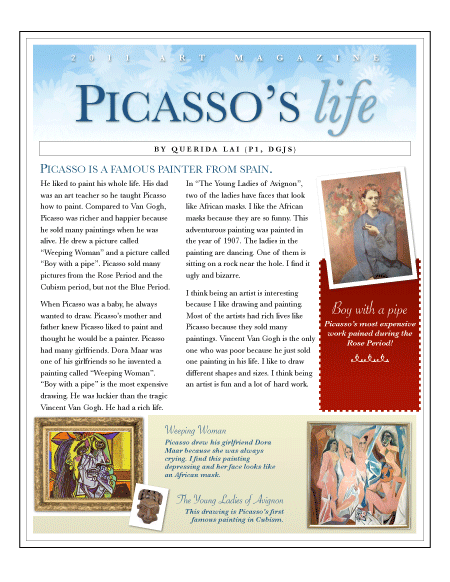
Read PDF
Program:
Writing Foundation
Querida Lai
P1, DGJS
Be an Artist
After learning about famous artists from a variety of art movements, students produced a biography of their favorite artists.
